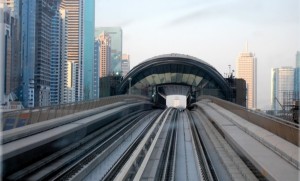By David George-Cosh www.thenational.ae
Narain Jashanmal holds up his mobile phone in a coffee shop at Dubai’s Mall of the Emirates. In a flash, he is able to track where the nearest Dubai Metro station is or, by moving the device around as if it were some futuristic computerised eye, locate similar points of interest.

Like something from the Tom Cruise sci-fi movie Minority Report, the mobile seems to “see” through walls and buildings, while displaying digital information and “virtual” pictures overlaying a live feed on its screen.
While the process might sound futuristic, advances in mobile technology and telecommunications mean it is happening right now using a technique called “augmented reality”.
At the heart of the technology is the mobile phone camera and lens. More than just a device to take snaps with, it acts as an interactive screen on which digital data are superimposed over a standard camera view.
“We’ve got these powerful phones now that we can do more than just make voice calls,” Mr Jashanmal says, moving the phone around to pick up information about the Mall of the Emirates metro station. “This is really cutting-edge stuff.”
Mr Jashanmal is using Layar, an augmented reality platform released last July and available for devices running the Android operating system, which is owned by Google.
The program, or application (app), he uses that displays the Metro data was created by the London-based software developer Howard Ogden to be used on the Layar system.
Mr Ogden has visited the UAE only once, in 2007 , long before the Dubai Metro opened.
To generate the data required he used information provided by the Roads and Transport Authority (RTA), as well as Dubai Metro websites. He compiled a detailed list of where the stations are located and how it operated to design the unofficial Metro Layar app.
“I put the application together in less than 24 hours,” he says.
As Mr Jashanmal moves the device, he is able to see where the nearest Metro station is, the specific Metro line, whether or not the station is operational and the distance to the station from his current position.
But because the RTA has not released a way to access scheduling information, the application cannot tell you when the next train is due.
Conceived by academics and embraced by the technology industry, augmented reality is becoming widely available to consumers through smartphones.
“It’s only now, where you’ve had the first Android phones and later the iPhone 3GS, where you’ve been able to enable augmented reality applications for consumers,” said Dr Windsor Holden, a principal analyst with the market and technology consultancy firm Juniper Research, based in Basingstoke in the UK.
As well as augmented reality software, smartphones offer high-speed broadband networks, increased battery life, digital compasses and GPS receivers, among other advanced technology.
The annual number of mobile downloadable apps featuring augmented reality content – ranging from the frivolous such as virtual lighters to the more serious like health centre locators – is expected to rocket from less than 1 million last year to more than 400 million by 2014, according to Juniper Research.
Many are free to download and most others cost less than US$1 (Dh3.6). However, the industry is forecast to become a US$732 million (Dh2.68 billion) business by 2014, up from less than US$2 million this year.
While the number of users who have downloaded the Dubai Metro app is fairly low, Mr Ogden says he will visit the UAE in the hope of working with property and tourism companies here to offer augmented reality apps of their own.
As an example of using augmented reality in the property industry, Mr Ogden aims to “virtually” place buildings that are still on the drawing board at the actual construction site. Prospective buyers would then be able to use an augmented reality-enabled mobile to see the virtual building in its intended location, to get a better sense of the scale of the project.
He has already used the Burj Khalifa as an example of the technology in action by placing the image of the building in a field in England. Using a mobile you can even take a walking tour around the world’s tallest tower.
“While it is just a proof of concept of something I’m working on, the Burj I created [is] a way for people around the world to marvel at this massive skyscraper,” says Mr Ogden.
Other commercial uses for augmented reality mobile devices could enable furniture companies, for example, to display their products in a virtual world design setting.
Last week, Mr Ogden finalised a pitch for a possible advertising campaign with a major US car manufacturer to create a three-dimensional scaled rendering of a car for potential customers in showrooms.
Currently, there are several other applications available for mobile devices that harness the same concept behind augmented reality.
Yelp, for instance, a website that collects restaurant reviews in the US and UK, released its iPhone application that features a “monocle” view where a user can point their mobile device at a city street and information about nearby eateries is displayed.
“If you don’t know where to go, you can use Yelp to help find a good place to eat,” says Mr Jashanmal. “There’s lots of reviews literally hanging from the sky as you walk around.”
In the Middle East, however, augmented reality apps will remain little more than unusual gimmicks unless local developers produce ones that everybody wants to use, says Yousef Tuqan Tuqan, the chief executive of Flip Media, a digital marketing agency based in Dubai.
“The UAE is one of the most mobile-connected countries in the world,” Mr Tuqan says. “All the factors are there: bandwidth is getting better; the development of applications is easier; mobile devices are getting smarter.
“The main thing now is trying to find the applications that fit it and make sense.”
Dr Holden says scepticism among the public and businesses is understandable because augmented reality is still a relatively new idea for most people.
“These applications are really still just testing out the water of the technology,” he says.
“The key behind augmented reality to become successful and monetised is that it must be part of the application, rather than just an add-on. It needs to enhance the application rather than to be a gimmick.”



















